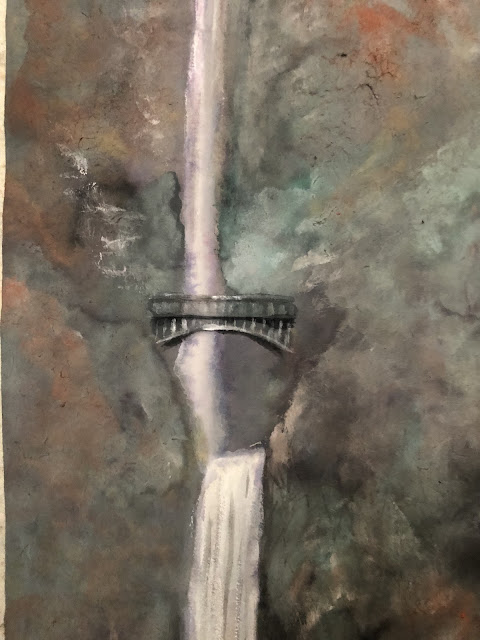I looked at my dried painting in day light and it certainly looked quite different from the dim incandescent light, and the color wasn't as exaggerated as when the painting was still wet.
I thought I could tone the color luminescence down further. This would be a good time to make the bluff side of the painting darker, since it was situated with the light behind it. I know in the classical sense, Chinese landscape paintings seldom pay homage to lighting effects, but my current work was too "contemporary". So what the heck.
The darkened right lower half the painting contrasted with the brighter left side of the painting. The darker sky also made the distant horizon more visible, showcasing the the distance perspective. I used a cold color, blue, to describe mountain ranges far away; as our atmosphere absorbed most of the other color wavelength.
Titanium white was used to bring out the Vista House, otherwise it would had been swallowed up by the red wash of the sky.
At a glance, the painting assumed a diagonal composition. I could see a play between the upper left hand corner and the lower right hand corner. I suppose my interest in photography encouraged me to pay attention to light values. Conversely I believe my painting hobby made my photography better, making me more aware of composition.
The one contrast I did not intend to make was the washed out contour lines from the landscape on the right. The repeated staining to adjust the tonal quality had buried my original lines. The visible shorelines on the left did not bode well with the vague shorelines on the right. This was definitely not a ying versus yang contrast.
What I did intend to contrast was the way I painted the lobes of the mountains. Normally the ridge of the lobes is the lightest and the darkest value is assigned to the area just beyond the contour line, where the gully between the lobes lie. This is the part where streams form and vegetations grow. The left side of the painting exemplified this practice. On the right side of the painting however, the ridge had the darkest value. I did that to suggest the presence of mist seeping through the mountain range from the right. The voids on the cliff face hopefully set the stage for the visualization. Hence the landscape on opposite sides of the river had opposite treatments to the ridges. Granted, this was a rather obscure and perhaps insignificant observation. Is this a case when some wine snob tells you that there is a hint of black currant, strawberry, chocolate and apricot in the wine and your response is forget the hype, just drink the damn wine?
Anyways this was what I arrived at.
The shorelines on the right side were re-established. The exposed rocky surface of the bluff was given more texture.
Somehow the painting looked quite desolate, reclusive. I was so tempted to paint in a few sail boats on the river, or some transiting geese. But then given the context that this was during the Covid-19 pandemic, perhaps it was appropriate to feel sort of detached and isolated?
Eventually I couldn't stop the itching, I had to do something to the painting, to make it a little more personable. I vividly recalled that white caps are a frequent occurrence in the gorge, hence the city of Hood River is a favorite wind surfing destination. It would be difficult to paint the waves and the white caps to scale, given the vastness of scenery. My excuse was that the painting was a little bit impressionistic anyways, so what the heck. If you want true realistic images, then get your own camera out.
Traditionally I would not have used titanium white to accent the white breakers, but since precedent was set by applying that to the Vista House, I felt justified.
Wow, that was different! My painting had just assumed a different persona. It now had drama.
The waves not only provided additional scenic texture, but also provided a foreground to the painting. Up until this point, I didn't even know the foreground was missing.
This might have been an example of the tail wagging the dog. Painting the water was never in the construct when I planned the painting; yet I couldn't take my eyes off of it now. In painting, as in life, sometimes a tiny insignificant afterthought could morph into a primary impetus and change your status quo totally.
After the novelty wore off, I decided to darken the foot of the bluff further more to create more of a contrast with the lit side of the painting.
The darkening was done by more ink staining from the back of the paper. I didn't want the ink to obscure too much of what was on the top layer of the paper already, I had already deposited too many layers of color, very unbecoming of what I was taught in traditional Chinese painting. The translucent nature of the paper allowed me the freedom to color from the back.
The paper was not mounted yet so it was creating its own shadows from all the localized dimples but the darkened bluff face at least looked credible, as it was in the shadow.
































